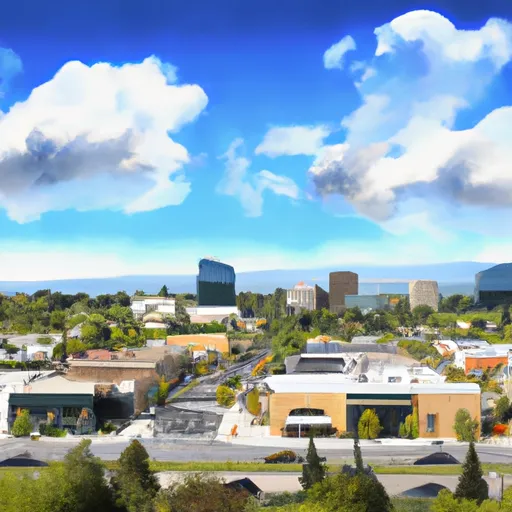-
 Snoflo Premium
Snoflo Premium
Get unlimited access to all our content
With no Ad interruptions! - Start Your Free Trial Login with existing account
Sunnyvale
Eden Index
Climate
9.2
•
Recreation
5.1
•
Community
7.4
•
Safeguard
7.3/10

Sunnyvale, California is a vibrant city located in the heart of Silicon Valley. Known for its mild Mediterranean climate, residents and visitors enjoy pleasant and sunny weather throughout the year. Summers are warm with temperatures averaging in the 80s°F (26-30°C), while winters are mild with temperatures rarely dropping below 50°F (10°C). The city experiences a limited amount of rainfall, typically between 13-20 inches annually, with the majority occurring in the winter months.
Hydrologically, Sunnyvale benefits from the Santa Clara Valley water basin. The city relies on imported water supplies from the San Francisco Public Utilities Commission and Santa Clara Valley Water District. Sunnyvale also actively promotes water conservation practices to ensure sustainable use of this precious resource.
Outdoor enthusiasts will find plenty of recreational opportunities in Sunnyvale. The city boasts numerous parks, green spaces, and trails that cater to various activities such as hiking, biking, and picnicking. Baylands Park is a popular destination offering picturesque views of the San Francisco Bay, wetlands, and wildlife habitats. Residents can also enjoy golfing at the Sunnyvale Golf Course or explore the Santa Cruz Mountains and nearby coastal areas for additional outdoor adventures. Overall, Sunnyvale provides an ideal environment for outdoor enthusiasts to enjoy a variety of activities in its beautiful surroundings.
What is the Eden Index?
The Snoflo Eden Index serves as a comprehensive rating system for regions, evaluating their desirability through a holistic assessment of climate health, outdoor recreation opportunities, and natural disaster risk, acknowledging the profound impact of these factors on livability and well-being.
Climate Health Indicator (CHI): 9.2
Sunnyvale receives approximately
385mm of rain per year,
with humidity levels near 62%
and air temperatures averaging around
16°C.
Sunnyvale has a plant hardyness factor of
9, meaning
plants and agriculture in this region tend to thrive here all year round.
By considering the ideal temperature range, reliable water supplies, clean air, and stable seasonal rain or snowpacks, the Climate Health Indicator (CHI) underscores the significance of a healthy climate as the foundation for quality living.
A healthy climate is paramount for ensuring a high quality of life and livability in a region, fostering both physical well-being and environmental harmony. This can be characterized by ideal temperatures, reliable access to water supplies, clean air, and consistent seasonal rain or snowpacks.
Weather Forecast
Streamflow Conditions
San Francisco Bay
Area Rivers
San Francisco Bay
Snowpack Depths
San Francisco Bay
Reservoir Storage Capacity
San Francisco Bay
Groundwater Levels
Recreational Opportunity Index (ROI): 5.1
The Recreational Opportunity Index (ROI) recognizes the value of outdoor recreational options, such as parks, hiking trails, camping sites, and fishing spots, while acknowledging that climate plays a pivotal role in ensuring the comfort and consistency of these experiences.
Access to outdoor recreational opportunities, encompassing activities such as parks, hiking, camping, and fishing, is crucial for overall well-being, and the climate plays a pivotal role in enabling and enhancing these experiences, ensuring that individuals can engage in nature-based activities comfortably and consistently.
Camping Areas
| Campground | Campsites | Reservations | Toilets | Showers | Elevation |
|---|---|---|---|---|---|
| Seacliff State Beach | 30 | 17 ft | |||
| Alameda County Fairgrounds RV | None | 328 ft | |||
| Portola Redwoods State Park | 53 | 504 ft | |||
| Sanborn - Skyline County Park | None | 1,278 ft | |||
| New Brighton State Beach | 102 | 93 ft | |||
| Big Basin Redwoods State Park | 102 | 1,005 ft | |||
| Henry Cowell Redwoods State Park | 113 | 658 ft | |||
| Santa Cruz Port District | 12 | 14 ft | |||
| Camp Parks Military | None | 351 ft | |||
| Sunol Regional Wilderness | None | 529 ft |
Nearby Ski Areas
Catastrophe Safeguard Index (CSI):
The Catastrophe Safeguard Index (CSI) recognizes that natural disaster risk, encompassing floods, fires, hurricanes, and tornadoes, can drastically affect safety and the overall appeal of an area.
The level of natural disaster risk in a region significantly affects safety and the overall livability, with climate change amplifying these risks by potentially increasing the frequency and intensity of events like floods, fires, hurricanes, and tornadoes, thereby posing substantial challenges to community resilience and well-being.
Community Resilience Indicator (CRI): 7.4
The Community Resilience Indicator (CRI) recognizes that education, healthcare, and socioeconomics are crucial to the well-being of a region. The CRI acknowledges the profound impact of these elements on residents' overall quality of life. By evaluating educational resources, healthcare accessibility, and economic inclusivity, the index captures the essential aspects that contribute to a thriving community, fostering resident satisfaction, equity, and social cohesion.

